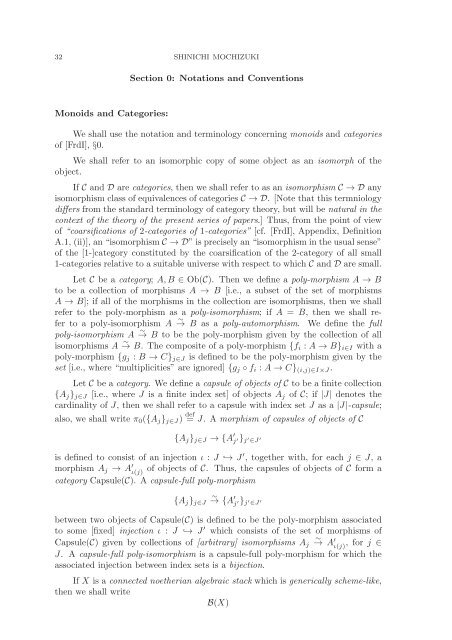Inter-universal Teichmuller Theory I: Construction of Hodge Theaters
Inter-universal Teichmuller Theory I: Construction of Hodge Theaters
Inter-universal Teichmuller Theory I: Construction of Hodge Theaters
You also want an ePaper? Increase the reach of your titles
YUMPU automatically turns print PDFs into web optimized ePapers that Google loves.
32 SHINICHI MOCHIZUKI<br />
Section 0: Notations and Conventions<br />
Monoids and Categories:<br />
We shall use the notation and terminology concerning monoids and categories<br />
<strong>of</strong> [FrdI], §0.<br />
We shall refer to an isomorphic copy <strong>of</strong> some object as an isomorph <strong>of</strong> the<br />
object.<br />
If C and D are categories, then we shall refer to as an isomorphism C→Dany<br />
isomorphism class <strong>of</strong> equivalences <strong>of</strong> categories C→D. [Note that this termniology<br />
differs from the standard terminology <strong>of</strong> category theory, but will be natural in the<br />
context <strong>of</strong> the theory <strong>of</strong> the present series <strong>of</strong> papers.] Thus, from the point <strong>of</strong> view<br />
<strong>of</strong> “coarsifications <strong>of</strong> 2-categories <strong>of</strong> 1-categories” [cf. [FrdI], Appendix, Definition<br />
A.1, (ii)], an “isomorphism C→D” is precisely an “isomorphism in the usual sense”<br />
<strong>of</strong> the [1-]category constituted by the coarsification <strong>of</strong> the 2-category <strong>of</strong> all small<br />
1-categories relative to a suitable universe with respect to which C and D are small.<br />
Let C be a category; A, B ∈ Ob(C). Then we define a poly-morphism A → B<br />
to be a collection <strong>of</strong> morphisms A → B [i.e., a subset <strong>of</strong> the set <strong>of</strong> morphisms<br />
A → B]; if all <strong>of</strong> the morphisms in the collection are isomorphisms, then we shall<br />
refer to the poly-morphism as a poly-isomorphism; if A = B, then we shall refer<br />
to a poly-isomorphism A → ∼ B as a poly-automorphism. We define the full<br />
poly-isomorphism A → ∼ B to be the poly-morphism given by the collection <strong>of</strong> all<br />
isomorphisms A → ∼ B. The composite <strong>of</strong> a poly-morphism {f i : A → B} i∈I with a<br />
poly-morphism {g j : B → C} j∈J is defined to be the poly-morphism given by the<br />
set [i.e., where “multiplicities” are ignored] {g j ◦ f i : A → C} (i,j)∈I×J .<br />
Let C be a category. We define a capsule <strong>of</strong> objects <strong>of</strong> C to be a finite collection<br />
{A j } j∈J [i.e., where J is a finite index set] <strong>of</strong> objects A j <strong>of</strong> C; if|J| denotes the<br />
cardinality <strong>of</strong> J, then we shall refer to a capsule with index set J as a |J|-capsule;<br />
also, we shall write π 0 ({A j } j∈J ) def<br />
= J. Amorphism <strong>of</strong> capsules <strong>of</strong> objects <strong>of</strong> C<br />
{A j } j∈J →{A ′ j ′} j ′ ∈J ′<br />
is defined to consist <strong>of</strong> an injection ι : J↩→ J ′ , together with, for each j ∈ J, a<br />
morphism A j → A ′ ι(j)<br />
<strong>of</strong> objects <strong>of</strong> C. Thus, the capsules <strong>of</strong> objects <strong>of</strong> C form a<br />
category Capsule(C). A capsule-full poly-morphism<br />
{A j } j∈J<br />
∼<br />
→{A<br />
′<br />
j ′} j′ ∈J ′<br />
between two objects <strong>of</strong> Capsule(C) is defined to be the poly-morphism associated<br />
to some [fixed] injection ι : J ↩→ J ′ which consists <strong>of</strong> the set <strong>of</strong> morphisms <strong>of</strong><br />
∼<br />
Capsule(C) given by collections <strong>of</strong> [arbitrary] isomorphisms A j → A<br />
′<br />
ι(j)<br />
,forj ∈<br />
J. A capsule-full poly-isomorphism is a capsule-full poly-morphism for which the<br />
associated injection between index sets is a bijection.<br />
If X is a connected noetherian algebraic stack which is generically scheme-like,<br />
then we shall write<br />
B(X)
















